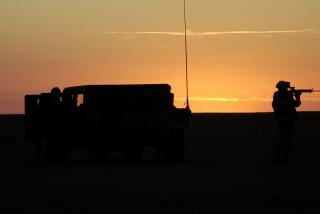Lightly Armed Marines Could Get Chewed Up, Some Experts Fear : Military: Mobile units designed for quick strikes are ill-suited to take on the entrenched Iraqis, analysts say.
- Share via
WASHINGTON — When the United States needed to move quickly to block a potential thrust by Saddam Hussein into Saudi Arabia, highly mobile Marine units were able to take up defensive positions in the desert within days to ensure that any Iraqi advance would be difficult and costly.
But almost five months later, with the battle of Kuwait taking shape as a collision between two huge war machines, the presence of 50,000 Marines in the desert is beginning to stir questions among some in the defense community.
Positioned beside heavy Army units on the allied “line in the sand,” the rapid deployment Marine troops face an armored Iraqi force across the border that has more and heavier tanks and greater firepower. And that force is becoming better entrenched by the day.
Unless the lighter-equipped Marines are pulled back and repositioned for their brand of quick amphibious assaults against the enemy, some defense analysts and former military officials fear, they could be chewed up in a large-scale land battle for which they are ill-suited.
“Certainly Marine M-60 tanks would be no match for Iraqi (Soviet-made) T-72s,” said retired Lt. Gen. William Odom. “And their doctrine says not to go deeper than 10 or 20 kilometers off the beach because their log (logistic) train is at sea,” added the former Army intelligence chief, who is now at the Hudson Institute, an Indianapolis think tank.
Questions about the Marines’ mission are one part of the debate simmering in the ranks of current and former military people about the U.S. strategic position as the U.N. Security Council deadline of Jan. 15 approaches for Iraq to withdraw from Kuwait or face possible military action.
Many are quick to point out that U.S. commanders in the Persian Gulf, fully aware of their troops’ relative strengths and weaknesses, would not use the Marines in a way that would magnify a mismatch. However, the disproportionate casualty rates the Marines suffered in Vietnam underscore the gravity of the issue.
In that war, where Marines were used as front-line soldiers, they suffered more than twice the Army’s dead and wounded rate, according to figures from the Army Center of Military History.
More specifically, of every 1,000 soldiers serving in Vietnam, seven were killed, as compared to 16 Marines. And for every 1,000 soldiers, 29 were killed or wounded, compared to 81 Marines.
To the argument that the Marines in Saudi Arabia would be drastically overmatched, ex-Marine officers offer several rebuttals, although they admit that the Army is better equipped and trained for hard-slogging ground warfare.
An Army armored division, for example, has six times more tanks, and more modern types, than the typical Marine division. The Marine division now in Saudi Arabia, situated in the desert between Saudi troops and an Army armored division, has twice the usual number of tanks, but its armor remains considerably inferior to its Army neighbors.
One ex-Marine argued, “To the Marines, tanks are just an adjunct--just one of the weapons we have,” while “the Army guys in armored divisions eat, sleep and breathe tank warfare.”
Sen. Charles S. Robb (D-Va.), who was a Marine combat officer in Vietnam, argued that the casualty statistics there probably reflect “the fact that a greater percentage of Marines were in front-line combat,” while the Army had a high proportion of soldiers holding terrain or in logistics support units.
“If you compared Marines to the (Army’s) 82nd Airborne or 1st Cavalry (divisions), I bet they’d be about the same,” Robb said last week, referring to the Army units that saw the most combat in Vietnam. Such a breakdown was not available from the Center of military History or the National Archives, however.
Robb, who recently visited the Persian Gulf, acknowledged that he has “some reservations” about deploying Marines on the ground in ways that reduce their flexibility and create additional logistic supply difficulties. But he is confident, he said, that U.S. generals in Saudi Arabia “appreciate the strength and weaknesses of forces, American and allied, under their command.”
A senior Marine general, now retired, complained that comparing a Marine brigade to an Army armored division “is comparing apples and oranges.” Both can have roughly the same number of personnel (about 15,000), but they are “different tools,” he said.
“Sure, if you have to go into a tank battle, or go 150 miles deep, I’d take an Army armored division or mechanized infantry division over the (Marine) amphibious assault force,” he said. “But I’d also take them over the Army airborne. That’s not what Marines or Army airborne were designed for.
“The airborne is for dropping behind enemy lines, and the Marines are for end runs,” he continued. “Like at Inchon (the amphibious landing during the Korean War), where we saved the day.”
Another retired Army general, also a Vietnam veteran, noted that the Army’s airborne divisions are equipped even more lightly than the Marines in terms of tanks and artillery. These parachute troops, also deployed at the front in Saudi Arabia, appear as vulnerable as the Marines and also ill-suited for straightforward ground offensives, he said.
“With airborne, there’s a rule of thumb--you’ve got about 72 hours to get in there and relieve them (after they are dropped), or you lose them,” he explained. These shock troops can’t sustain heavy fighting within enemy lines, so the main force must break through to them within about three days. He viewed the role and limits of Marines in similar fashion.
“I can’t imagine that (Gen. H. Norman) Schwarzkopf (who commands U.S. troops in the gulf) would want to use Marines for deep penetration missions overland when he has those armored divisions,” said the ex-Marine general.
Then why not pull them out? “Politics,” according to one former Army officer. “The Marines have a large and effective lobby in Congress, like (former Marines) Chuck Robb and John Glenn (D-Ohio) in the Senate,” he said. In a time of shrinking defense budgets, every service wants to demonstrate its merit to forestall deep funding cuts in coming years.
The Army and Marine Corps have always argued about “roles and missions,” but the Army chief of staff, Gen. Carl E. Vuono, and the Marine Corps commandant, Gen. Alfred M. Gray, have reportedly had more heated exchanges than their predecessors over which service can best provide the United States with light, fast, mobile forces in the future.
More to Read
Sign up for Essential California
The most important California stories and recommendations in your inbox every morning.
You may occasionally receive promotional content from the Los Angeles Times.













